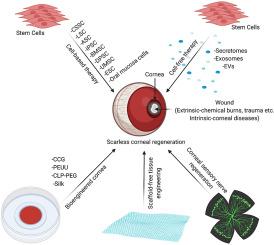Progress in Retinal and Eye Research ( IF 18.6 ) Pub Date : 2021-09-14 , DOI: 10.1016/j.preteyeres.2021.101011 Ajay Kumar 1 , Hongmin Yun 1 , Martha L Funderburgh 1 , Yiqin Du 2

|
The cornea is the outmost layer of the eye, unique in its transparency and strength. The cornea not only transmits the light essential for vision, also refracts light, giving focus to images. Each of the three layers of the cornea has properties essential for the function of vision. Although the epithelium can often recover from injury quickly by cell division, loss of limbal stem cells can cause severe corneal surface abnormalities leading to corneal blindness. Disruption of the stromal extracellular matrix and loss of cells determining this structure, the keratocytes, leads to corneal opacity. Corneal endothelium is the inner part of the cornea without self-renewal capacity. It is very important to maintain corneal dehydration and transparency. Permanent damage to the corneal stroma or endothelium can be effectively treated by corneal transplantation; however, there are drawbacks to this procedure, including a shortage of donors, the need for continuing treatment to prevent rejection, and limits to the survival of the graft, averaging 10–20 years. There exists a need for new strategies to promote regeneration of the stromal structure and restore vision. This review highlights critical contributions in regenerative medicine with the aim of corneal reconstruction after injury or disease. These approaches include corneal stromal stem cells, corneal limbal stem cells, embryonic stem cells, and other adult stem cells, as well as induced pluripotent stem cells. Stem cell-derived trophic factors in the forms of secretomes or exosomes for corneal regeneration are also discussed. Corneal sensory nerve regeneration promoting corneal transparency is discussed. This article provides description of the up-to-date options for corneal regeneration and presents exciting possible avenues for future studies toward clinical applications for corneal regeneration.
中文翻译:

角膜再生疗法
角膜是眼睛的最外层,具有独特的透明度和强度。角膜不仅传输视觉所必需的光线,还折射光线,使图像聚焦。角膜的三层中的每一层都具有视觉功能所必需的特性。虽然上皮通常可以通过细胞分裂迅速从损伤中恢复,但角膜缘干细胞的丢失会导致严重的角膜表面异常,从而导致角膜失明。基质细胞外基质的破坏和决定这种结构的细胞(角膜形成细胞)的丢失导致角膜混浊。角膜内皮是角膜的内部,没有自我更新能力。保持角膜脱水和透明度非常重要。角膜基质或内皮的永久性损伤可以通过角膜移植得到有效治疗;然而,这种手术也有缺点,包括供体短缺、需要持续治疗以防止排斥反应,以及移植物的平均存活时间有限(平均 10-20 年)。需要新的策略来促进基质结构的再生和恢复视力。这篇综述强调了再生医学的重要贡献,目的是在受伤或疾病后重建角膜。这些方法包括角膜基质干细胞、角膜缘干细胞、胚胎干细胞和其他成体干细胞,以及诱导多能干细胞。还讨论了用于角膜再生的分泌体或外泌体形式的干细胞衍生营养因子。讨论了促进角膜透明度的角膜感觉神经再生。本文描述了角膜再生的最新选择,并为未来角膜再生临床应用研究提供了令人兴奋的可能途径。











































 京公网安备 11010802027423号
京公网安备 11010802027423号